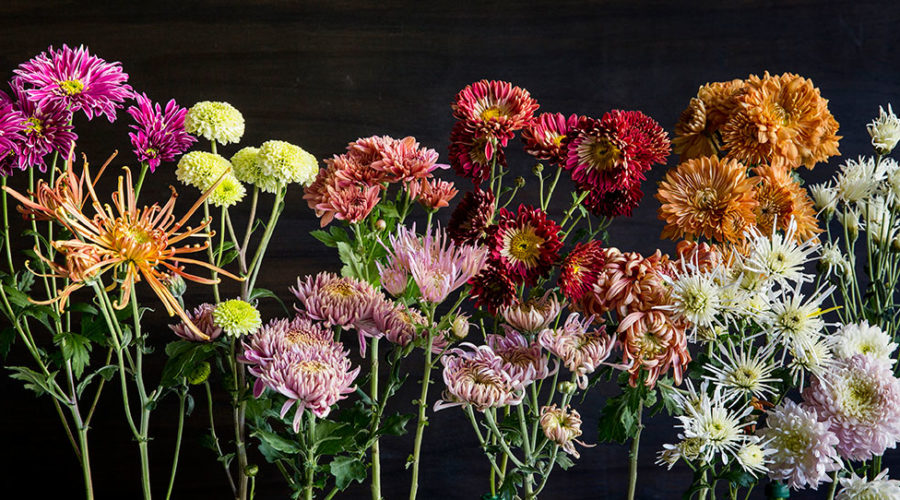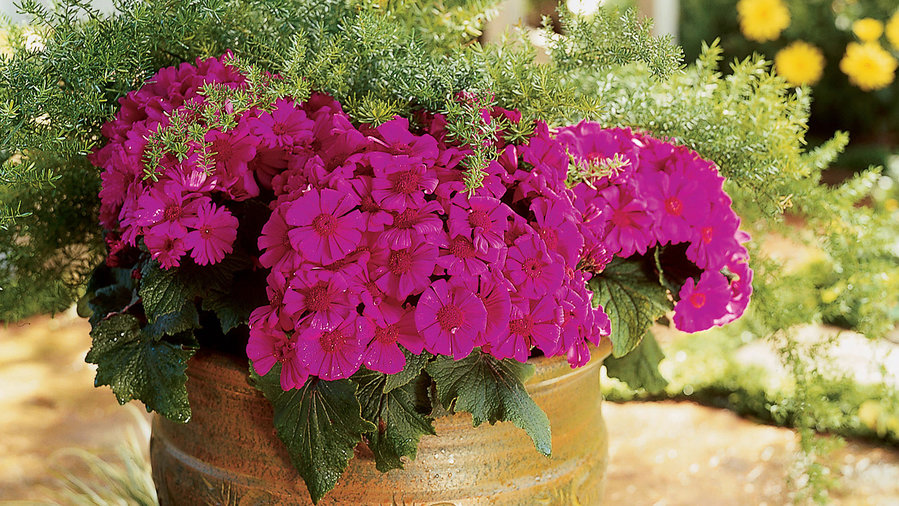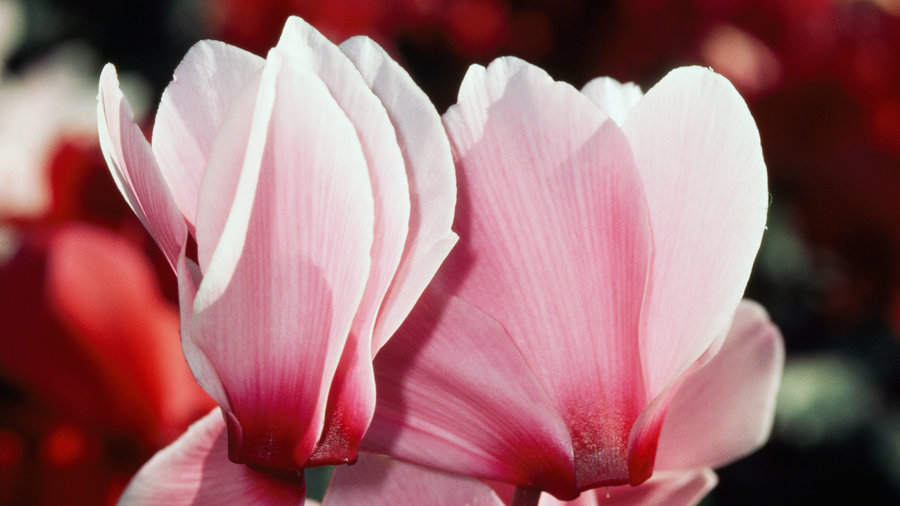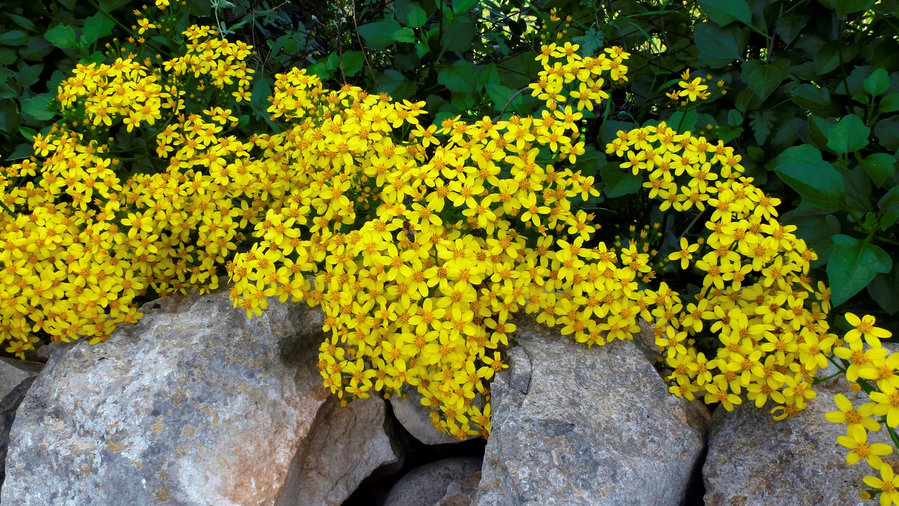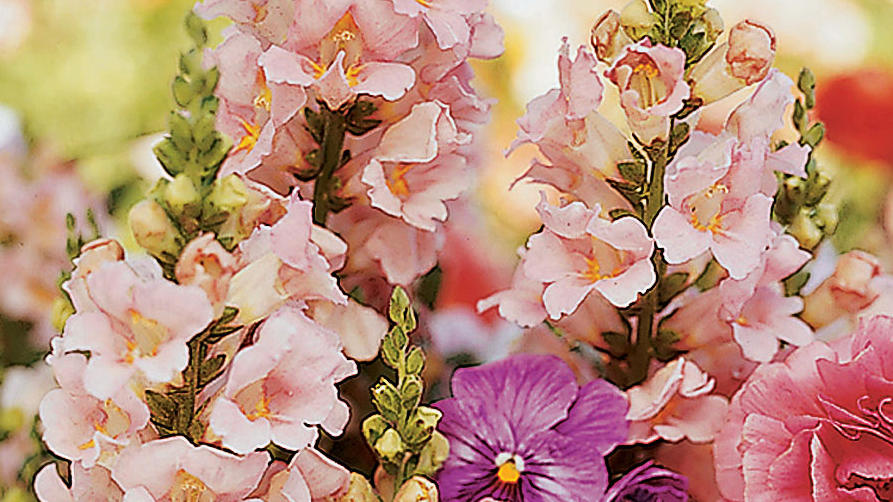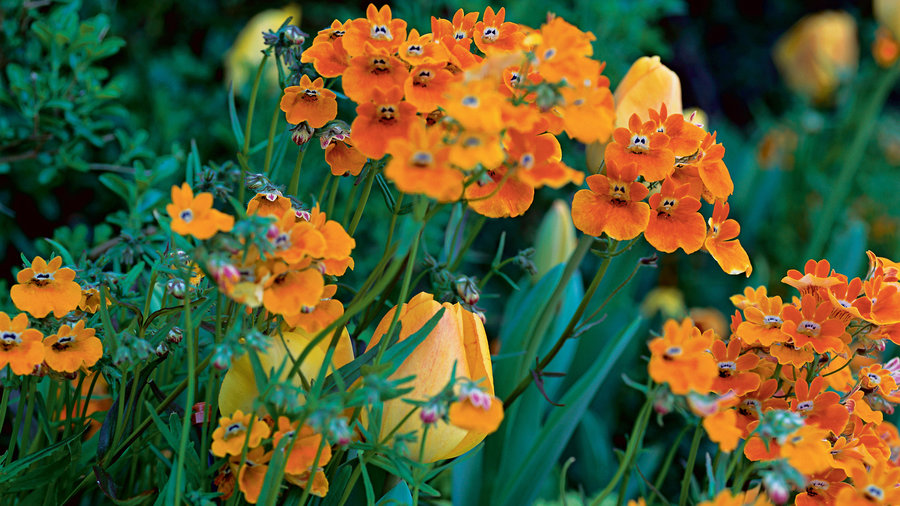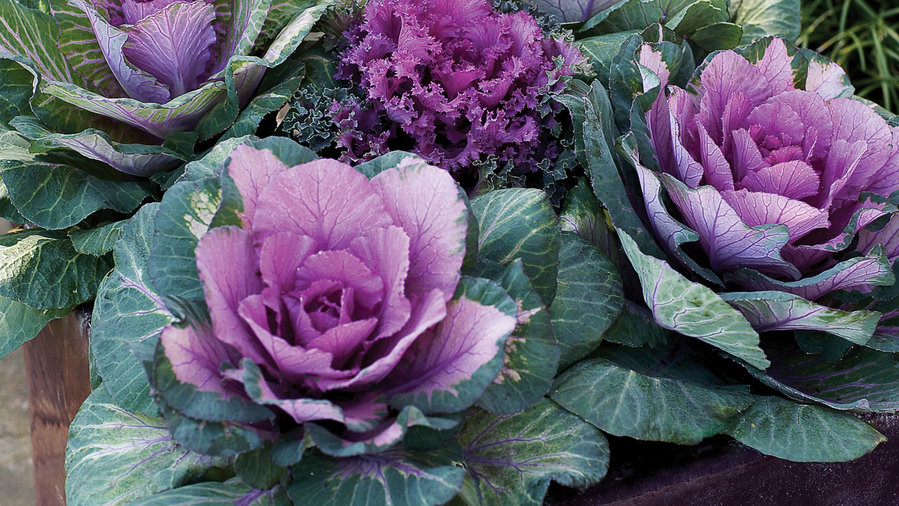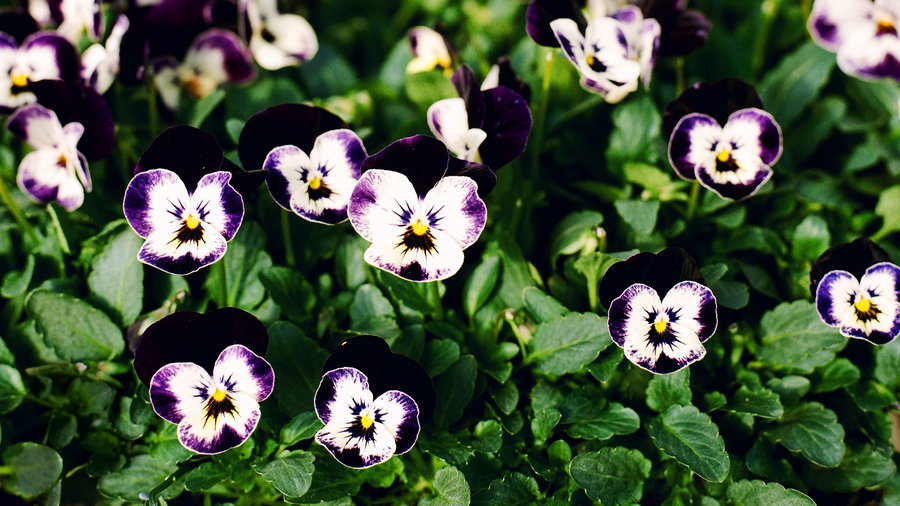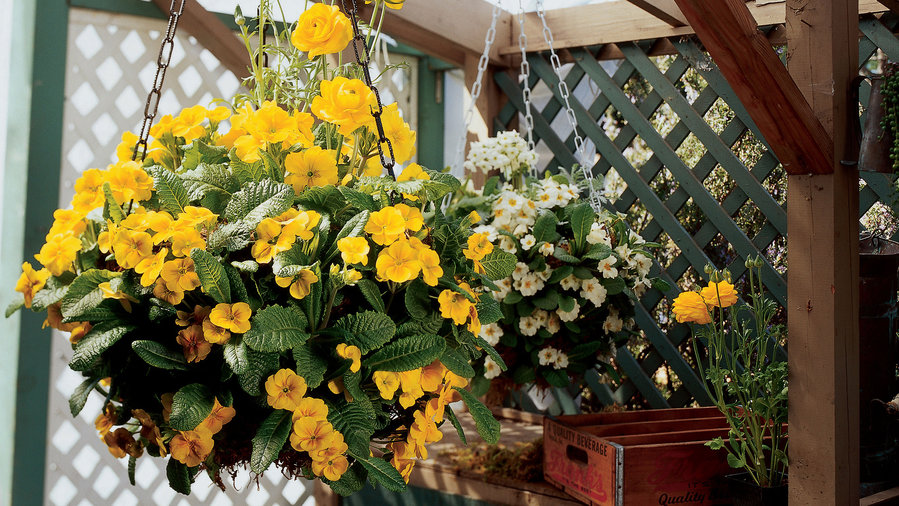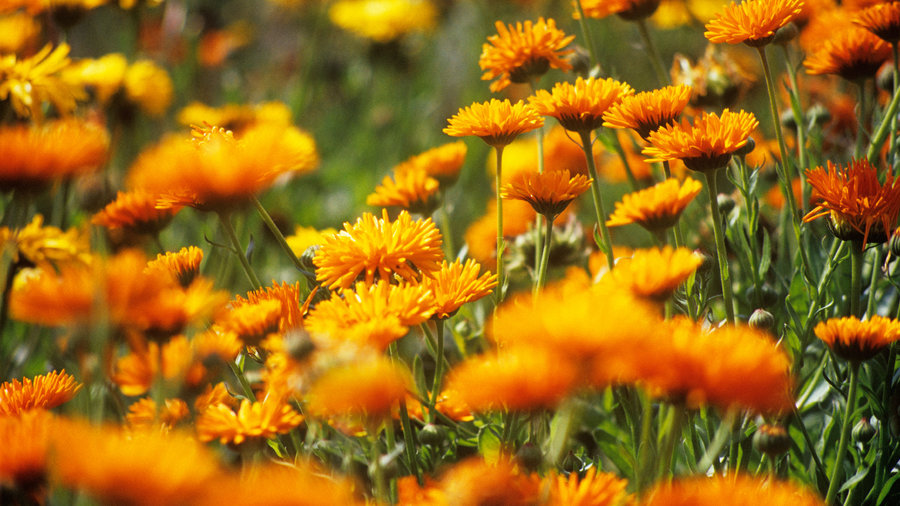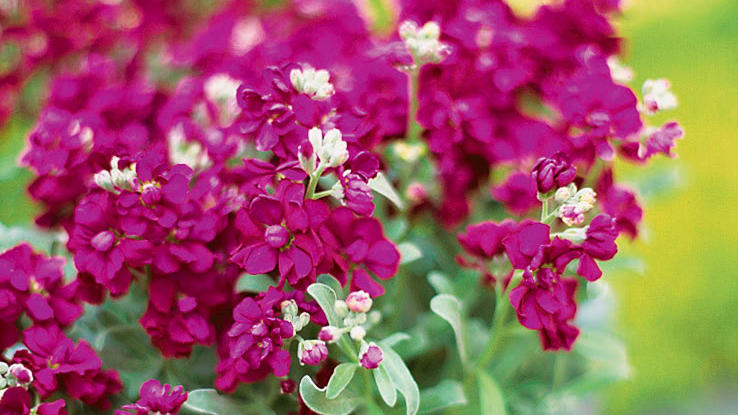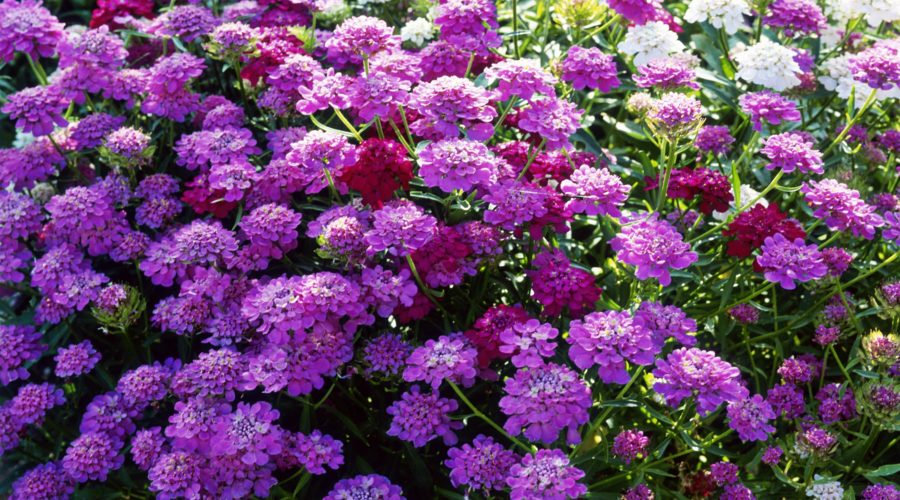Photo: Rob D. Brodman
Hellebores
Plant hellebore, also known as lenten rose, for distinctive flowers and foliage in winter and early spring. The flowers on these buttercup relatives are usually shaped like cups or bells, either outward facing or drooping. They range in color from white and green through pink and red, deep purple to black (‘Party Dress’ is pictured here). Flowers persist beyond bloom periods, gradually turning green. Plants can take some sun but tend to look a bit peaked if blasted with too much hot, direct sun. Give them moderate to regular water, depending on species. Plant in well-drained soil amended with plenty of organic matter; they look particularly fetching in rock gardens.
Chrysanthemums
Mums, or often grown as annuals, are classified according to their shape. Whether you choose an ‘irregular incurve,’ ‘spider mum,’ ‘football,’ or ‘quill’ type, you can’t go wrong for the fall garden. Pro tip: When your plants are about 12” tall, pinch out the top center 3” to encourage low branching and multiple, manageable-sized flowers.
Photo: Thomas J. Story
Cineraria
Made for the shade, florists’ cineraria adds intense color to dark corners of the garden. Cineraria grows to 2 feet high and wide, with daisies coming in solid white, pink, red, purple, and every shade in between. Plants need partial or full shade along with regular water and loose, rich soil to keep thriving. They peter out after blooming, so toss them on the compost heap after they’re finished, even where perennial. Here it’s combined with asparagus fern in a 15-inch-wide glazed terra-cotta pot.
Photo: Thomas J. Story
Cyclamen
Few blooms celebrate “winter” like cyclamen. Pretty flowers in shades of white, pink, rose, and red are carried atop a clump of sturdy, attractive leaves. Flowers resemble shooting stars or butterflies. Large-flowered florists’ cyclamen (pictured) is most often seen as a container-grown gift plant (they even sell them at Trader Joe’s), but cyclamen makes a great bedding plant in temperate climates. Smaller-flowered, hardier plants are better adapted to outdoor use, but will be fine in a container as long as it’s kept out of direct sunlight. Give them part shade and regular water and they’ll provide bright and colorful blooms for your fall and winter garden.
Photo by Jerry Pavia
Winter jasmine
The slender, willowy stems on winter jasmine (Jasminum nudiflorum) stand out beautifully in a winter landscape. Bright yellow flowers appear in winter or early spring, before handsome glossy, three-leafleted leaves unfurl. Don’t be disappointed though – the flowers on this jasmine are unscented. The vine will reach 4 feet high and 7 feet wide if unsupported. Train it on a trellis, fence, or wall and it will grow to 15 feet tall. Winter jasmine can tolerate less-than-perfect conditions but will be a most prolific bloomer in full sun and good soil. To keep it tidy, cut back heavily before spring growth occurs, and pinch as needed throughout the year to control growth.
Photo: Thomas J. Story
Iceland poppy
With their tall, leafless stems that dance in the breeze, Iceland poppies (Papaver nudicaule) are graceful companions to many cool-season plants. Iceland poppies grow 1 to 2 feet tall; flowers come in every warm shade between white and red, with peaches and corals looking especially striking against an early frost. They need full sun and moderate to regular water, but they’re native to boreal and subpolar regions of the world, so they tolerate cooler temperatures well. In mild-winter climates, set out plants in fall or winter for months of cool-season color. Pick flowers freely to prolong the show. In cold winter areas, sow seed in earliest spring for summer bloom; or set out plants in fall for bloom the following year.
Photo: Thomas J. Story
Snapdragon
Snapdragons are among the best flowers for borders and cuttings, and they’ll provide colorful blooms throughout fall and winter in milder climates.(In cold climates, plant in spring.) Flowers come in every color imaginable, and are divided into upper and lower “jaws.” Some have double flowers, some are bell-shaped, and some blooms look like azaleas. Flowers shoot from 1-3 feet tall and 6 inches to 2 feet wide. Set out plants from fall to spring in mild-winter areas; all take full sun and regular water. Here, we’ve paired them with purple pansies and peach ranunculus for a striking display.
Photo by Baac3nes / Getty Images
Heaths and heathers have quite the following. They’re grown for their prostrate, shrubby, mat-forming habit; their tiny, evergreen leaves; and their showers of small white, pink, red, or purple flowers. Blooms are typically bell shaped, urn shaped, or tubular. Plants can be small and mounding, no taller than 6 inches high or a tall upright or sprawling shrub, as high as 6 to 10 feet. Heath needs excellent drainage and acidic soil, while heather grows in bogs and at high altitudes; sandy soil amended with organic matter is ideal, but don’t be afraid to add these plants to a rock garden. Gently shear or cut off faded flower spikes, but don’t cut to bare wood as new growth might not resprout. White bell winter heath (Erica x darleyensis ‘Silberschmelze’) are a nice choice for cool-season blooms, as are the Lady in White, Lady in Pink, and Lady in Red Scotch heathers (Calluna vulgaris ‘Nr 580,’ ‘Nr 5157,’ and ‘Nr 5163,’ respectively).
Nemesia
Nemesia grows to 2 feet tall and 1 foot wide, with small bright green leaves, upright stems, and bright flowers in nearly every color. All nemesia need well-drained soil, full sun, and regular water. Some nemesia have intensely fragrant blossoms; others are unscented. If you live in a mild-winter climate, you can sow seeds in fall for winter and spring bloom. Pinch to improve bushiness. Remove faded flowers to prolong bloom.
Photo: Sheila Schmitz
Ornamental kale
Giant rosettes of frilly leaves in lavender, rose, white, and creamy yellow make ornamental kales favorite additions to the winter garden. Because these showy cabbage relatives tolerate cold weather and can hold their brilliant color all the way into spring, they’re ideal for display on porches, patios, or beside entryways, or for massing in garden beds. They grow 1 to 2 feet tall. Plant kale in full sun or light shade, and do so as soon as possible so heads develop fully; the color will intensify in the cold. Water regularly and feed every other week with a dilute liquid fertilizer like fish emulsion. Here, four smooth-leaved ‘Sunset’ kale plants anchor the corners of a plum-colored square container while crinkly purple kale springs from the center.
Photo: Gabriela Hasbun
Viola
We all remember the singing violas from Disney’s Alice in Wonderland, and planting these sweet flowers in your garden will have you humming “All in the Golden Afternoon” as well. Like their relative the pansy, violas (Viola tricolor) light up gray days with happy colors and sweet fragrance. They’re a wonderful overwintering plant and self-sow readily. Rain really beats down pansy flowers, but violas bounce back quickly. Violas, also known by their twee name “Johnny jump-up,” are smaller than pansies (between the size of a nickel and a quarter) but have more flowers per plant. They come in purple, blue, yellow, white, and cream and bi-colored varieties (‘Penny Mickey’ is pictured here). Use violas for mass color in borders and edging, as covers for spring bulbs, or for quick color in winter containers. Violas take sun or part shade. Pick flowers to prolong bloom. Remove plants in summer if they begin to look ragged, but they will self-sow if allowed to.
Photo: Thomas J. Story
Pansy
Like their siblings the violas, when it comes to cool-season blooms, pansies (Viola bicolor) are the hardest-working flowers in the game. These low-growing plants (6 to 10 inches tall) are top sellers year after year for good reason. They deliver lots of bright blooms over a long period, come in a huge range of colors ― both solids and bicolors ― and keep going through the winter in much of the West. (‘Dynamite Blotch’ is pictured here.) The large-flowered, faced varieties may catch your eye first in nurseries. But when planted en masse, nonfaced, single-colored varieties often make a bigger statement.
English primrose
Most primroses bloom in spring or summer, but English primrose (as well as fairy primroses and Chinese primroses) are also excellent choices for winter color. Circular flowers arise either alone or in clusters from a foliage rosette. English primrose (pictured here) comes in nearly every color and grows 8 to 12 inches high and 9 inches wide. Primroses can take full sun in cooler climates, part to full shade otherwise. All need regular water. Here, yellow primroses and ranunculus fill the hanging basket in the foreground; white primroses fill the basket behind.
Photo: Marion Brenner
Calendula
Daisy-like calendula (aka pot marigold; Calendula officinalis) provides sunny color from late fall through spring in mild-winter climates, and are long lasting in a vase. Choose classic orange and bright yellow, or opt for subtler shades of apricot, cream, and soft yellow. Branching plants are 1 to 2 feet high and 1 to 1½ feet wide and look great as masses of color or in a container. Calendula plants take full sun and moderate water. They will tolerate many soils as long as they have good drainage. Remove the spent flowers to prolong bloom, or allow the seed heads to form at the end of the summer and resow in early spring.
Photo: Thomas J. Story
Stock
Some things never go out of style, and stock is as classic as a little black dress and pearls. Plant this old-fashioned favorite for its narrow gray-green leaves and profuse spikes of spicy-sweet smelling flowers. Take your pick of white, pink, red, purple, lavender, blue, yellow, and peachy-cream. Stock varieties range from 1 to 3 feet tall and 10 to 16 inches wide, and make a soft and fragrant addition to bouquets. All perform best in full sun or light shade and appreciate regular water. In cold-winter areas, plant in earliest spring (choose early bloomers). Stock needs good drainage, so where rainfall is heavy, plant in raised beds.
Photo by Ron Evans / Getty Images
Candytuft
Candytuft plants grow 8 to 12 inches high and wide; their narrow, shiny dark green leaves look great all year, but their colorful flowers will steal the show from fall through spring. Long-stem varieties are carried on stems long enough to cut for bouquets, but dwarf varieties are a darling addition to any garden. Choose ‘Fairy’ series (pictured), or for white flowers, choose ‘Autumn Beauty,’ or ‘Autumn Snow.’ They bloom in spring and again in fall. Plants thrive in full sun or part shade and do best with regular water. Candytuft needs well-drained soil and should be sheared lightly after bloom to stimulate new growth.

